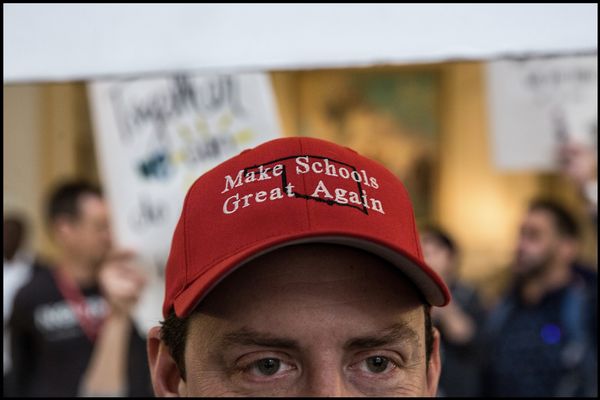
“There has been no change to this date, and there will be no change,” Donald Trump said on his Truth Social platform this week. “All money will be due and payable starting AUGUST 1, 2025 – no extensions will be granted.”
There had, in fact, been a change. The 90-day “pause” on the highest tariffs threatened by Trump on his so-called “liberation day” in April elapsed on Wednesday. But with just three trade agreements in place, instead of the 300 once promised, the White House had switched one deadline for another.
Optimists, who seem to include many on Wall Street, interpreted this latest slippage as evidence that Trump will never go through with the most damaging tariffs.
But as he published a slew of tariff letters to individual countries throughout the week, less hopeful observers sensed a reinvigorated Trump, who seemed to be channelling the spirit of “liberation day”, when he held up that gameshow-style card, promising punitive levies on countries that had “looted, pillaged, raped and plundered” the US.
These letters – all released on Truth Social and featuring Trump’s thick signature in Sharpie pen – included swingeing tariff rates of 50% on Brazil, 30% on Sri Lanka and 35% on Canada. As in April, some pointed to issues well beyond the sphere of trade – the fate of Brazil’s ex-president Jair Bolsonaro, for example, and alleged fentanyl trafficking from Canada.
“If we compare where we are now with where we were in April, many of the tariffs that he is describing and the letters that he’s sent out are very similar to what he described then,” said Prof Maurice Obstfeld, a senior fellow at the Peterson Institute for International Economics. “I think what this shows is that the bluster in April about, ‘we’re going to negotiate all these trade deals’, was way overhyped.”
The stock markets have broadly shrugged off Trump’s latest flurry of threats, apparently assuming this latest deadline will slide by, like the end of the 90-day pause. After plunging after “liberation day”, the S&P 500 index of leading shares posted a record high – though the renewed hostilities with Canada did prompt a wobble on Friday.
Obstfeld notes that bond markets appear less upbeat, betting that the Federal Reserve will reduce interest rates four times in the next 12 months. “Bond markets are pricing in all these interest rate cuts, which are predicated on a slowdown in the economy and a slowdown in inflation. If that’s what you believe, that the economy’s going to slow down, it’s hard to see why the stock market is behaving as it is,” he says. “Something’s got to give at some point.”
The dollar has also confounded economists’ expectations, suffering its worst first half in 50 years, despite the textbook response to tariffs being a stronger currency.
Aside from the hit to the currency, there is scant evidence of a significant impact on the US economy, however, with jobs data coming in well above expectations last week, for example.
But experts believe that may not last. “We’ve seen a lot of resilience in the data to date, but I think a lot of that is down to front loading – people trying to get in ahead of the tariffs, and boosting activity as a result,” says Ben May, the director of global macro research at Oxford Economics. “We’re now at the point where that’s going to be fading. The fact that we haven’t seen that weakness yet doesn’t mean it’s not going to come.”
Neil Shearing, the chief global economist at consultancy Capital Economics, suggests the full impact of the tariffs has been muted by the agreement the US recently made with China – and would be further contained, if a handful of other hoped-for deals with major economies materialise.
“We don’t know where the tariffs will land, but importantly from the perspective of the US, now a deal has been done with the UK, China, Vietnam, if one is done with India and the EU, and then Mexico and Canada, that covers just over 75% of US trade.” He describes the impact on the US in that case as a “mild stagflationary shock” – pushing inflation above the Federal Reserve’s 3% target and putting the brakes on growth.
The Federal Reserve’s chair, Jerome Powell, who has repeatedly been attacked by Trump for failing to bring rates down faster, recently made clear that tariffs were to blame. “Essentially all inflation forecasts for the United States went up materially as a consequence of the tariffs. We didn’t overreact, in fact we didn’t react at all. We’re simply taking some time,” he said.
Even if the average tariff rate for most countries ends up being something between 10 and 20% – much lower than the “liberation day” rates – it marks a historic shift for the global trading system.
“From a US perspective this is still a generational increase in tariffs,” says Shearing. “It would take the effective tariff rate to somewhere between 15 and 20%, having been at 2.5%. It takes you back to tariff rates last seen in the 1940s.”
Forecasters, including the International Monetary Fund and the Bank of England, have also repeatedly highlighted the cost to the economy of the uncertainty surrounding Trump’s tariffs, which leave firms without the information they need to make investment decisions.
While Trump’s latest barrage of letters and pronouncements did not answer the question of where tariffs will ultimately land, it did make one thing clear: that uncertainty is very likely to continue for a long time to come.
Meanwhile, there appears little evidence that the policy is achieving the president’s stated aim of bringing manufacturing jobs flooding back to the US. “It’s unlikely we’re going to see a manufacturing renaissance any time soon because of tariffs,” says Obstfeld. “It’s very hard to see how that goal is achieved.”







